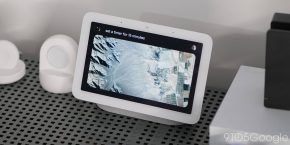
According to strings found in a build of the Nest Hub’s frontend software, Google is actively developing (and is nearing launch of) a new speed test feature for the popular Nest Hub smart display. The feature could possibly allow for troubleshooting connection issues when devices are unresponsive, or perhaps just exist as a standalone feature.
We aren’t sure how this speed test feature will actually work on the Nest Hub — it could be triggered via a standalone “Hey Google, check my internet speed” command, it could appear on the display when the Hub detects an issue, or it could trigger by way of some other method. The feature has to do with smart home device control, the strings suggest, while also alluding to a “run button”:
"HOME_AUTOMATION_DEVICE_CONTROL_SPEED_TEST" "HOME_AUTOMATION_DEVICE_CONTROL_SPEED_TEST_RUN_BUTTON"
A speed test feature for Google Home devices is not entirely unheard of. A download-only speed test function has been present in Home’s local API for a long while, but is largely unused. It’s possible that this feature is built on top of that existing function, while also adding support for upload speed measurement:
"supportsNetworkDownloadSpeedTest" "supportsNetworkUploadSpeedTest"
During a speed test, the Hub will measure download speed, then upload speed, and then finish by recording your results. It is unclear whether Google plans to implement ping/latency measurement as well, like in the popular Ookla Speedtest.
The Google Nest Hub will display results in Kbps, Mbps, and for the real speed demons among us, Gbps is supported as well. The Hub will follow each test by assigning your network a rating from “not so great” to “lightning fast.”
"Your last speed test on {DATE} was {RATING}"
"lightning fast"
"blazing fast"
"pretty snappy"
"good"
"Ok"
"a little slow"
"not so great"
Any modern home relies on internet access to function, so it makes sense for Google to implement a feature that can uncover connection issues from a central device. Issues that affect your Hub might not be present on other devices, which can complicate trying to solve them. A future evolution of this feature could advise users to move to an area with better coverage or less interference, so as to make sure device control remains entirely uninterrupted.
We expect a rollout of this feature to happen soon, as styling and animations are essentially complete. We look forward to covering it in full when it’s released.
FTC: We use income earning auto affiliate links. More.


Comments